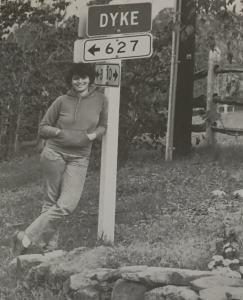
Joan E. Biren, born in 1944 in Washington, D.C., was an accomplished photographer before the publication of Eye to Eye: Portraits of Lesbians in 1979. Biren attended Mount Holyoke College , earned a M.A. in Communications from American University, and attended three years of doctoral photography program at Oxford University before dropping out to join the United States women’s movement. Upon returning to the United States, Biren signed on as a photographer for The Furies, the newspaper for the lesbian-separatist Furies Collective, formed in 1971.
Biren understood the urgent need for realistic, truth-telling lesbian representation. In 1979, JEB published the first photography book of lesbian portraits taken by a lesbian photographer: Eye to Eye: Portraits of Lesbians. Her career of lesbian photography started as simply as taking a self portrait. She writes:
I had never seen a picture of two women kissing and I wanted to see it. I borrowed a camera, but I didn’t even know anybody else I could ask to pose for it. So I held the camera out at arm’s length and kissed my lover, Sharon, and took the picture. That’s my first lesbian photograph. [1]
[ Read more about the history of lesbian photography→ ]
Building on the tradition of lesbian photography, Biren’s Eye to Eye amassed photographs of lesbians — their faces, bodies, and families. In addition to collecting portraits, Eye to Eye also collected stories, visually demonstrating all the different shades and mores of lesbian life. Biren wrote in her proposal for the book that she wanted her photos to “fill a void that [existed] within the lesbian community for some realistic self-portraits” which could “reach out beyond that community to let other people know more about lesbian lives.” [4] To do so, Biren paired each portrait with an interview of the subject or with poetry about the lesbian experience. The women in Eye To Eye telling their stories themselves contributed to the radical tradition of women testifying about their lives, truth-telling, and unapologetically asserting their humanity.
The photos in Eye to Eye demonstrate Biren’s desire to show the diversity of lesbian life; to fight back against the pigeonholing of the lesbian identity — illegal, crazy, pervert. The collection includes Black lesbians, rural lesbians, urban lesbians, disabled lesbians, pagan lesbians, polyamorous lesbians, pagan lesbians, mentally ill lesbians, politically active lesbians, lesbian addicts, and lesbian mothers. The array of representation simultaneously deconstructs toxic notions of lesbianism and demonstrates the heterogeneous character of the lesbian experience, revealing a throughline of strength and pride rooted in their lesbianism. [3]
With Haunted Looking, I recreate pages of Eye to Eye in order to imitate my experience encountering these images in the archive. Haunted Looking encourages the player to at once engage with the images and narrative of Biren’s portrait, but also to be aware of their own positionality in looking at these portraits.
[ Read more about the project→ ]
[1] Joan E. Biren, quoted in “Lesbian Photography” by Judith Scharwz, Eye to Eye: Portraits of Lesbians by Joan E. Biren, Joan E. Biren papers, Smith College Special Collections, Northampton, MA.
[2] “Lesbians Portraits / Photography by JEB,” Joan E. Biren papers, Smith College Special Collections, Northampton, MA.
[3] “Summary of portraits, Eye to Eye,” Joan E. Biren papers, Smith College Special Collections, Northampton, MA.